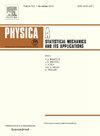Information cocooning and polarization of opinions in a mobile population
IF 2.8
3区 物理与天体物理
Q2 PHYSICS, MULTIDISCIPLINARY
Physica A: Statistical Mechanics and its Applications
Pub Date : 2025-02-01
DOI:10.1016/j.physa.2024.130322
引用次数: 0
Abstract
Information cocooning, referring to the phenomena that individuals become trapped in self-imposed cocoons by only encountering and accepting information that aligns with their own opinions, may hinder the normal dissemination of information. Numerous studies focused on how information cocoons emerge and how to avoid their disadvantages. In previous works, it is usually assumed that individuals are well-mixed in a population or located statically on certain regular or complex networks. Here, we explore the phenomena of information cocooning and opinion polarization among individuals who exhibit directional migration, favoring movement towards neighbors with similar opinions. In scenarios without migration, the social radius is a pivotal parameter that influences the development of various opinion dynamics, including neutral consensus, radicalization, and polarization. When directional migration is introduced, information cocooning can occur, leading to the fragmentation of the population into distinct opinion clusters that are spatially distant from one another. Within each cluster, radicalization of opinions is a common phenomenon. However, when considering the population as a whole, opinion dynamics may encompass polarization and consensus. We investigate the impact of the social radius and migration speed on the formation of information cocooning. We find that, the number of opinion clusters decreases with the increase of social radius. Moreover, a small social radius leads to more opinion clusters but milder opinions, whereas large ones result in less number of opinion clusters with more individuals holding radical opinions. This work can help us better understand the formation of information cocoons and opinion polarization in real life.
求助全文
约1分钟内获得全文
求助全文
来源期刊
CiteScore
7.20
自引率
9.10%
发文量
852
审稿时长
6.6 months
期刊介绍:
Physica A: Statistical Mechanics and its Applications
Recognized by the European Physical Society
Physica A publishes research in the field of statistical mechanics and its applications.
Statistical mechanics sets out to explain the behaviour of macroscopic systems by studying the statistical properties of their microscopic constituents.
Applications of the techniques of statistical mechanics are widespread, and include: applications to physical systems such as solids, liquids and gases; applications to chemical and biological systems (colloids, interfaces, complex fluids, polymers and biopolymers, cell physics); and other interdisciplinary applications to for instance biological, economical and sociological systems.

 求助内容:
求助内容: 应助结果提醒方式:
应助结果提醒方式:


